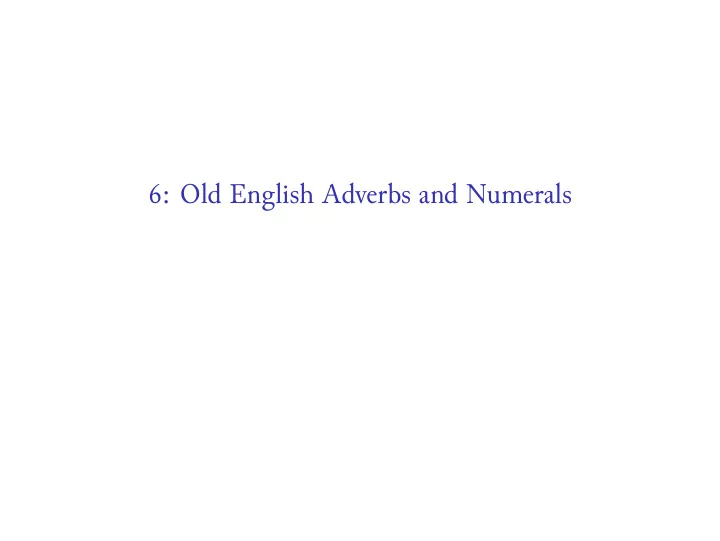

6: Old English Adverbs and Numerals
Adverb Formation in Modern English adjective + -ly : easy > easily scarce > scarcely recent > recently noun + -wise : length > lengthwise clock > clockwise unmarked: fast hard yesterday there also
Adverb Formation in Old English adjective + e : lang (long) > lange (for a long time) gearu (ready) > gearwe (readily) nīwe (new) > nīwe (newly, recently) īeþe (easy) > ēaþe (easily) word + -līce : heard (hard) > heardlīce (severely) ār (honour) > ārlīce (honourably) ǣr (early) > ǣrlīce (early) word + -inga/unga : ealle (all) > eallunga (entirely) ierre (anger) > ierringa (angrily) simple stems: oft (often) wel (well) ēac (also, auch )
Adverb Formation in Old English word in acc.: efen (equal) > efen (equally) āwiht (anything) > āwiht (at all) adjective in gen.: ealle (all) > ealles (entirely) word in dat. sg.: nīed (necessity) > nīede (necessarily) word in dat. pl.: hwīl (a while) > hwīlum (sometimes) with prep.: tōmiddes (prep. + gen., amidst) tōgædere (prep. + adv., together) wiþūtan (prep. + adv., outside) ymbūtan (prep. + adv., around) begeondan (prep. + adv., beyond)
Adverb or Adjective? ▶ Adverb missenlīce ‘variously’ ▶ Adjective missenlic ‘various’: ▶ Strong ismn missenlice ▶ Strong napmf missenlice ▶ Strong asf missenlice ▶ Weak nasn missenlice ▶ Weak nsf missenlice → Rely on context! ▶ Weak adjectives are preceded by a pronoun or modifier ▶ All adjectives modify a noun, whether or not implied
Adverb or Adjective? An adjective typically occurs close to a noun: ▶ Immediately preceding a noun: Se tila cyning ▶ Closely following a noun: Crist nāmode Ābel rihtwisne Waldend þone gōdan
Adverb or Adjective? Adverbs will often appear adjacent to the verb or adjective they modify, but especially when modifying verbs they can move more freely, e.g.: ▶ Adjacent to the verb that is modified: hē hearde fēoll ▶ Adjacent to subject/object, modifying a clause-final verb: hīe hrædlīce for mægenlēaste swulton
Adverb Comparison -or , -ost : gearwe > gearwor > gearwost with i -mutation: feorr > fierr > firrest nēah > nēar > nīehst -mest : inne > innerra > innemest sīþ > sīþra > sīþemest/sīþest norþ > norþerra > norþmest multiroot: wel > bet > betst micle > mā > mǣst
Numeral Declension Cardinals Only ān , twēgen , þrīe are typically declined. They decline as strong or weak adjectives, depending on context. When ān is weak, it is an adverb meaning “alone” rather than “one”. Hīe sind ān god, on ānre godcundnesse and on ānum gecynde. Hē hæfde twēgene sunu, Ermenrēd and Ercenberht. Her cōm Port on Brytene and his twēgan sunan. Nis nā gedafenlīc þæt þes man āna bēo. Ordinals Always decline as weak adjectives, except ōðer, which is always strong. On þām fiftēoþan geare cōm Godes word ofer Iōhannem.
Ordinal Formation An ordinal is formed by adding -ta or -ða to the cardinal stem. Beyond twelve, that stem usually ends in -o , either because the -n of the ‘teen’-morpheme is dropped or because an o is added to the ‘ty’-element. Ān , twēgen , þrīe have slightly different ordinals. # Cardinal Ordinal 1 ān forma, fyrsta 2 twēgen æfterra, ōþer 3 þrīe þridda 4 fēower fēorþa 11 endleofan endlyfta 12 twelf twelfta 13 þrēotīne þrēotēoþa 30 þrītig þrītigoþa
Example Sentences Be þissum ðinge gē habbað oft gehȳred. Unriht weaxeð ealles tō wīde. Neron cwæþ, “Gang mē nēar hider, and sege mē hwæt þū þence.” Iōhannes fulluht ðwōh þone mannan wiðūtan, and nān ðing wiðinnan. Hwīlum Brettas, hwīlum eft Seaxan sige geslōgon. On þam twelftan dæge cristes acennednysse comon þa þry tungelwitegan. Stephanus wæs se fyrmesta; oðer Philippus; þridda Procorus. He ða fæste feowertig daga ⁊ feowertig nihta.
Verse Form Rhythm Alliteration ▶ Two verses per long line ▶ One or both lifts in the (separated by a caesura) a-verse ▶ Two lifts (= beats) per verse ▶ First lift in the b-verse ▶ Variable number of drops ▶ Vowels alliterate among (= unstressed syllables) themselves ▶ (Sometimes hypermetric ▶ sc , sp , st keep to themselves lines) Oft Scýld Scéfing scéaþena þréatum sc-alliteration “ 5 mónegum mǽgþum méodosetla oftéah, égsode éorlas, syððan ǽrest wéarð vowel alliteration féasceaft fúnden. He þæs frófre gebád, wéox under wólcnum, wéorðmyndum þáh, oðþæt him ǽghwỳlc ýmbsìttendra 10 ofer hrónràde hýran scólde, gómban gýldan. Þæt wæs gód cýning! ”
Recommend
More recommend